Rare Breeds and Rat Catchers!
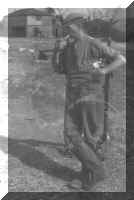 In 1881 rat catching was also noted as an occupation! By this time Lord
Bristol of Ickworth , whose predecessors had acquired some local land and the
tile of Lord of the Manor of Tuddenham in 1698 4 was adding to those
acquisitions so that by the turn of the 20th. century there was very little land
or property here, apart from the church and charity holdings, which did not
belong to his estate. He never lived in the village but let out some land to
tenants and installed a bailiff to work his own acres, this in turn created a
lot of employment for local people.
In 1881 rat catching was also noted as an occupation! By this time Lord
Bristol of Ickworth , whose predecessors had acquired some local land and the
tile of Lord of the Manor of Tuddenham in 1698 4 was adding to those
acquisitions so that by the turn of the 20th. century there was very little land
or property here, apart from the church and charity holdings, which did not
belong to his estate. He never lived in the village but let out some land to
tenants and installed a bailiff to work his own acres, this in turn created a
lot of employment for local people.
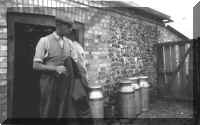 In the early 1900's the local farms supplied the villagers with milk,
sometimes collected from the farm in a jug. By the middle of the century dairy
cattle walking along the public roads to and from their pasture twice a day for
milking was a common sight, the cows would be hand milked and the bulk of the
milk treated, put into large churns 5 and collected from the farm gate by the
'milk lorry'. Today there are no dairy herds left here although we still have a
bottled milk delivery service and there are a few cows and calves at Longwood
farm where they also have some rarer breeds like the longhorned highland cattle.
In the early 1900's the local farms supplied the villagers with milk,
sometimes collected from the farm in a jug. By the middle of the century dairy
cattle walking along the public roads to and from their pasture twice a day for
milking was a common sight, the cows would be hand milked and the bulk of the
milk treated, put into large churns 5 and collected from the farm gate by the
'milk lorry'. Today there are no dairy herds left here although we still have a
bottled milk delivery service and there are a few cows and calves at Longwood
farm where they also have some rarer breeds like the longhorned highland cattle.
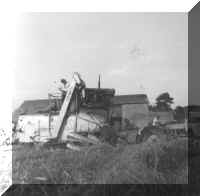 Following the Industrial Revolution as mechanisation increased, the faithful
workhorses were gradually replaced by tractors which completed the work much
more efficiently and faster, it also drastically cut down the amount of manpower
required to work the land and now one man in isolation with a machine is the
normal procedure. Suffolk Punch horses which used to pull the ploughs and carts
are becoming an endangered species with only about 400 left in the whole
country. Five of these belong to Gordon Brown, one of the main farmers here, who
uses them for breeding and showing. Our soil is particularly suited to grass
growing and in consequence we now have stables and studs which serve the local
racing industry so race horses in the fields are a common sight.
Following the Industrial Revolution as mechanisation increased, the faithful
workhorses were gradually replaced by tractors which completed the work much
more efficiently and faster, it also drastically cut down the amount of manpower
required to work the land and now one man in isolation with a machine is the
normal procedure. Suffolk Punch horses which used to pull the ploughs and carts
are becoming an endangered species with only about 400 left in the whole
country. Five of these belong to Gordon Brown, one of the main farmers here, who
uses them for breeding and showing. Our soil is particularly suited to grass
growing and in consequence we now have stables and studs which serve the local
racing industry so race horses in the fields are a common sight.
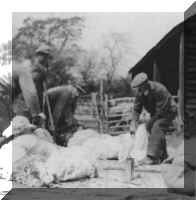 During the war everyone was encouraged to'Dig for Victory' on every available
piece of land, allotments became popular and many families kept a pig and a few
hens and grew their own vegetables. Even the RAF Commander grew cabbages in the
area around his HQ.6 on Tuddenham airfield. Allotments shown on old maps of the
village7 have now disappeared as imported, reasonably priced fruit and
vegetables have become readily available in supermarkets both in and out of
season. People are more health conscious today and the demand for organic
produce has increased dramatically, Longwood Farm has diversified into this and
built up a reputation for quality foods grown and produced locally in the
organic way some of which is retailed through their farm shop in Tuddenham.
During the war everyone was encouraged to'Dig for Victory' on every available
piece of land, allotments became popular and many families kept a pig and a few
hens and grew their own vegetables. Even the RAF Commander grew cabbages in the
area around his HQ.6 on Tuddenham airfield. Allotments shown on old maps of the
village7 have now disappeared as imported, reasonably priced fruit and
vegetables have become readily available in supermarkets both in and out of
season. People are more health conscious today and the demand for organic
produce has increased dramatically, Longwood Farm has diversified into this and
built up a reputation for quality foods grown and produced locally in the
organic way some of which is retailed through their farm shop in Tuddenham.
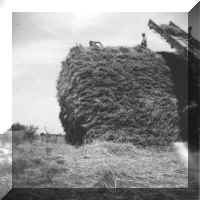 The number of personnel employed in farming here now is minimal, probably
less than 5%, although agriculture is still the main industry. As well as corn
and root crops such as potatoes, carrots and onions, sugar beet is one of the
main crops with oilseed rape and linseed oil, with the profusion of bright
yellow and blue flowers and pungent smell increasingly popular. With artificial
fertilisers and additives no ground needs to be left fallow, polythene sheeting
covering the land warms the ground and retains the moisture so that more than
one crop per season in not unusual. This policy has resulted in grain
The number of personnel employed in farming here now is minimal, probably
less than 5%, although agriculture is still the main industry. As well as corn
and root crops such as potatoes, carrots and onions, sugar beet is one of the
main crops with oilseed rape and linseed oil, with the profusion of bright
yellow and blue flowers and pungent smell increasingly popular. With artificial
fertilisers and additives no ground needs to be left fallow, polythene sheeting
covering the land warms the ground and retains the moisture so that more than
one crop per season in not unusual. This policy has resulted in grain 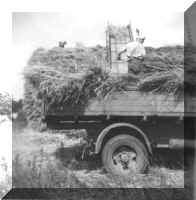 mountains
and surplus crops so that now farmers are told what and how much they are
allowed to grow and in some cases are paid to 'set aside' fields. Farming is a
changing industry but remains vital to the local economy and the welfare of
Tuddenham residents.
mountains
and surplus crops so that now farmers are told what and how much they are
allowed to grow and in some cases are paid to 'set aside' fields. Farming is a
changing industry but remains vital to the local economy and the welfare of
Tuddenham residents.
©2001 Esme Murfitt